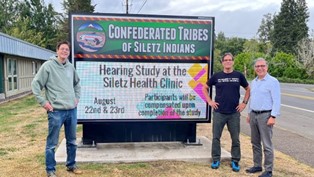Native American Heritage Month: Honoring American Indian and Alaska Native Workers
Posted on by
There are currently 574 federally recognized tribes across the United States. American Indian and Alaska Native (AI/AN) workers play a crucial role in the U.S. workforce and economy, yet little is known about the hazards that AI/AN workers face. This is the first in a series of blog posts by the National Institute for Occupational Safety and Health (NIOSH) honoring Native American Heritage Month. This post provides an overview of the NIOSH AI/AN Initiative and the AI/AN Worker Safety and Health Strategic Plan. We will also share examples of how NIOSH is working to advance the plan. The next blog post will focus on the AI/AN workforce participation by industry and occupation. The final post will highlight the NIOSH Health Hazard Evaluation Program, a free resource that tribes can use to learn whether workers are exposed to hazardous or harmful workplace conditions.
AI/AN Workers
In 2022, AI/AN workers accounted for 2.8 million of the total U.S. workforce, yet little is known about occupational safety and health among these workers. National data on occupational injuries, illnesses, and fatalities among AI/AN workers are scarce and there is limited information on worker safety and health activities in tribal communities. As sovereign nations, AI/AN tribes maintain a government-to-government relationship with the United States.
Watch for the next blog in this series to learn more information about the AI/AN workforce.
NIOSH AI/AN Initiative
In 2013, NIOSH launched the AI/AN Initiative to partner with AI/AN tribes, tribal communities, tribal organizations, and other partners to identify priority issues, conduct outreach, and determine how NIOSH research could provide better occupational safety and health support to tribal communities. Hear from tribal workers on the importance of worker safety and health in their communities in these videos.
AI/AN Worker Safety and Health Strategic Plan
NIOSH facilitated the development of the American Indian and Alaska Native Worker Safety and Health Strategic Plan with the content and scope informed by visiting reservations, attending tribal public health conferences, convening workshops, and interacting with tribes and partners. The plan serves as a guide for the nation to conduct and develop priority research and outreach activities to prevent injuries, illnesses, and fatalities among AI/AN workers. The plan can be viewed as a starting point to encourage collaboration and activities to advance AI/AN worker safety and health. The objectives are organized into four areas of focus: (1) research, (2) practice, (3) policy, and (4) capacity building. These were established based on input from two tribal occupational safety and health workshops, held in 2015 and 2019, and a review of other relevant strategic plans.
Examples of How NIOSH is Working to Advance the Plan
Tribal Emergency Response Worker Well-being in Washington, Idaho, and Oregon
The primary goal of this NIOSH-funded research project is to better understand the risk and protective factors that may uniquely impact the well-being of tribal emergency response workers. The project will explore risk factors that influence well-being, such as exposure to violence or stressful events, symptoms of depression and post-traumatic stress disorder, shift work, and lack of perceived supervisor and coworker support. Additionally, protective factors such as gratitude, social support, and resilience will be explored.
Occupational Mortality of American Indian/Alaska Native population, 2020-2022
Occupational safety and health information among AI/AN workers is limited. NIOSH researchers are developing a report exploring fatal work-related injuries among AI/AN workers by industry and occupation. Additionally, the report will identify potential areas for intervention. More information will be shared on the NIOSH AI/AN Initiative web page when the report is published.

Hearing Loss Prevention in the Confederated Tribes of Siletz Indians
The Confederated Tribes of Siletz Indians (CTSI) in Oregon, wanted to protect the hearing of their tribal members, especially their workers. CTSI collaborated with NIOSH hearing loss prevention researchers to evaluate the effectiveness of a hearing protection insertion tool, called Sert-A-Plug®. This new, patented tool created by CTSI members was a finalist in the Occupational Safety and Health Administration-NIOSH Hear and Now Noise Safety Challenge to promote innovative hearing products and solutions. This project established collaboration between Federal, State, tribal, and academic institutions to foster and develop targeted hearing conservation programs and culturally-relevant interventions and prevention messaging.
We Want to Hear From You
NIOSH seeks to work with tribes, tribal organizations, and partners to continue to advance the AI/AN Worker Safety and Health Strategic Plan to help build capacity within AI/AN communities, and we want to hear from you. Share your thoughts with us at tribalworkers@cdc.gov.
- What tribal worker safety and health activities and programs are active in your community?
- How can we best share information about worker safety and health with tribal communities?
Elizabeth Dalsey, MA, is a Health Communication Specialist in the NIOSH Western States Division.
Posted on by

